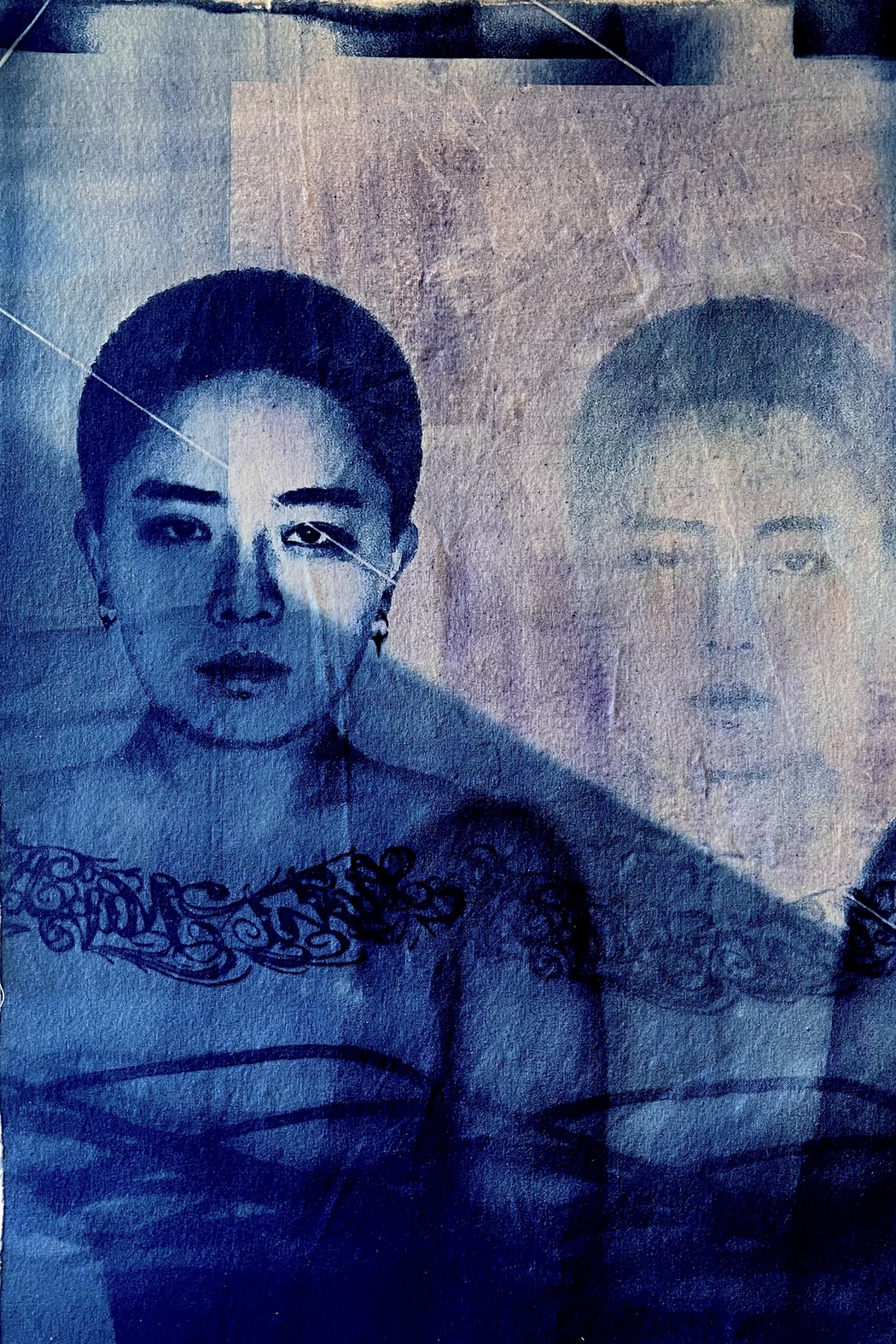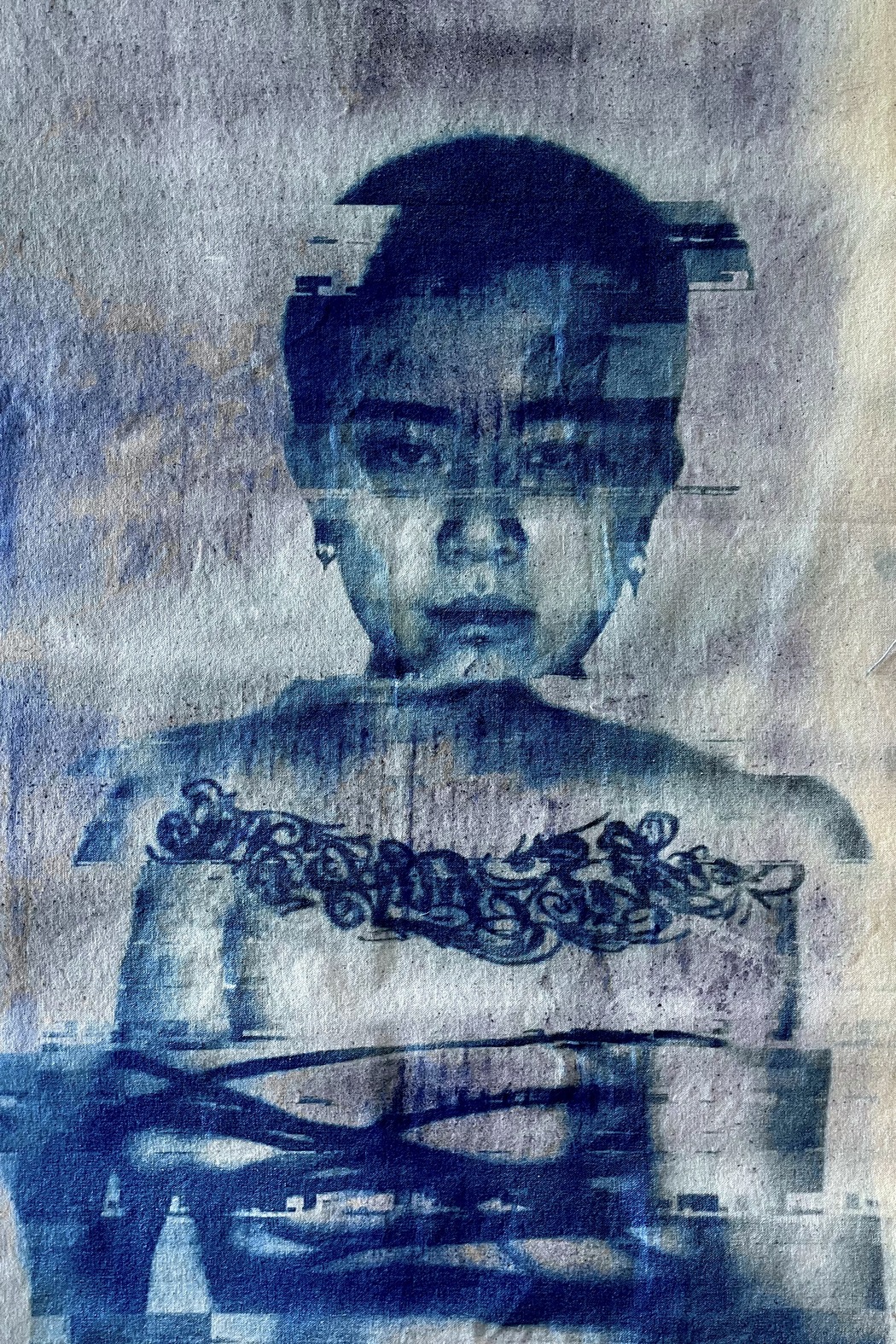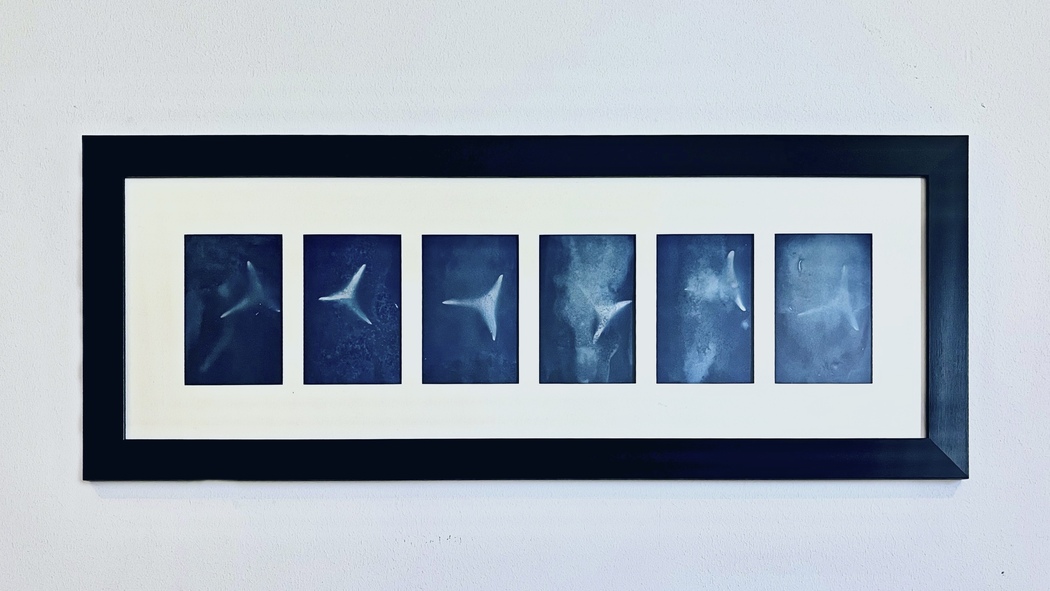Yichen He
Year of birth: 1996.
Where do you live: Shanghai.
Your education:
Beijing Film Academy – Bachelor’s Degree.
University of the Arts London – Master’s Degree.
Describe your art in three words: Identity, Gender, Fluidity.
Your discipline: Drawing, Mixed Media.
The combination of cyanotype art and color seems to be a defining feature in your work. Could you describe your process for incorporating this technique, and why you chose it to represent your themes?
When creating my work, I try to stretch my body by changing poses, thereby using my body as a medium to articulate the nuanced interplay of fluidity and hesitation that characterizes my inner world. This physical expression is deeply intertwined with my identity as a queer individual, serving as a reflection of my lived experience and the complexities of my existence. When I aim to capture the fluidity of life on canvas, I need to embrace methods that involve uncertainty. I believe cyanotype fits this perfectly, as it relies on sunlight and water to develop—both elements that are constantly changing. Thus, cyanotype not only meets but also enhances my artistic requirements, allowing me to create works that are deeply resonant with the themes of change, fluidity, and the exploration of identity.
Your artist statement references the tension between the subconscious and conscious in your work. How do you navigate this duality while creating, and how do you see it impacting the final artwork?
While creating, the subconscious brings raw emotions and intentions, while the conscious mind focuses on refining and structuring these elements. I often let intuition lead the way at first, and then use logic to adjust and refine the work later. This duality makes the work not only emotionally charged but also clearly expressed, ultimately presenting multiple layers of meaning that provoke thought and resonance in the viewer.
You have worked in both London and Shanghai, two very different cultural contexts. How have your experiences in these cities influenced your artistic approach and the themes you explore?
It’s undeniable that these two cities share some common traits, such as their openness to both old and new cultures. However, my experiences of living and working in these cities have made me aware of subtle yet significant differences between them. These differences have prompted deeper reflection and provided me with meaningful guidance. London’s fusion of modern and historical art encouraged me to think worldwide and taught me to explore while honoring tradition. However, Shanghai’s blend of the ancient elegancy and the thriving diversity inspired my investigation of transformation, identity, and cultural hybridity, demonstrating to me the complexity of modernity and urbanization. How I see and make has been influenced by both locations.
Your current work explores the combination of cyanotype and digital art. Can you share your thoughts on the fusion of these two media and what it brings to your creative process?
Traditional cyanotype has a distinct texture and a sense of unpredictability, whereas digital art provides infinite accuracy and potential. Combining the two allows me to use digital technology to create more intricate compositions and color layers while maintaining the warmth and spontaneity of craftsmanship in my work. In addition to broadening my creative vocabulary, this union gives my work a more complex visual and emotional expression by balancing tradition with contemporary.
Your work explores themes of identity, gender, and mobility. How do you approach these concepts when starting a new piece? Do they evolve as you work, or do you have a clear direction from the start?
When starting a new piece, I usually have a preliminary idea around themes like identity, gender, and fluidity, but these concepts tend to evolve during the creation process. I prefer to let the work ‘grow’ rather than follow a rigid path. Just as I said before, I would let intuition lead at first. This open attitude allows me to explore the multiple meanings of these complex themes more deeply and immersively, while also giving the work more fluidity and vitality. In the end, these pieces reflect both my initial thoughts and the new inspirations that emerged during the creative journey.
Could you tell us about a specific work in your portfolio that you feel deeply connected to? What was its inspiration, and what does it represent to you personally?
I took a nude self-portrait and bound my chest with rope. The act of ‘binding’ is not just a physical constraint but also a metaphor for the societal norms and gazes that confine me, or even symbolizing my inner self-imprisonment. I then created various effects for the image in Photoshop and printed it onto film. These films were then placed on cyanotype fabric, and after exposure to sunlight, they formed unique images. Meanwhile, I layered lace lingerie onto the fabric as a subtle suggestion and playful commentary, telling the story behind the photo in a cheeky way. This approach to creation is both a subversion of traditional portraiture and a complex exploration of identity, restraint, and freedom.
Your works have been selected for the Louvre International Art Exhibition and have received significant recognition. How has this affected your artistic journey and your approach to future projects?
It was a significant milestone for me for sure. It not only boosted my confidence in my artistic practice but also made me realize that my work can resonate on an international stage. This acknowledgment encourages me to explore new media and themes more boldly, while also placing greater emphasis on the depth and universality of my work. Moving forward, I hope to continue challenging myself and create pieces that reflect personal insights while engaging with a global audience.




Leave a Reply